Wine Heat Stability Testing

Nick Smith, Enologist, University of Minnesota
Publisher’s note: This article is the third installment in a four-part series for winemakers by Nick Smith with the Enology Laboratory at the University of Minnesota. To read the previous articles, visit the “Winemaking” section of Midwest Wine Press and see Nick’s May 21, 2012 and May 1, 2012 articles.
A simple chart or formula indicating the proper bentonite treatment to achieve heat stability would be wonderful. Unfortunately no such chart exists. Heat stability, in particular, happens to be a gray area in wine science. No single test or result can provide the answer to the ultimate question: Is my wine heat stable? Testing can only provide information on the level of stability, subject to the conditions of a given test. Let’s take a look at what heat stability tests accomplish and how to interpret the results.
The most common methods for analyzing heat stability involve placing samples in an incubator or a water bath at a specific temperature for a specific amount of time. In the hot box method, prepared samples are placed in an incubator for 24 to 48 hours at 50C. After heating, the samples are cooled and observations on haze formation are noted. The samples are often placed in a cooler or refrigerator and observed over a period of a week or longer. Samples can also be placed in a water bath. The amount of time and temperature varies. 80C for 6 hours is common. Large wineries will perform a version of both types of tests as one test can indicate a higher or lower level of stability than the other.
Initially the ultimate question was: Is my wine heat stable? A more precise version of that question should be: Is my wine heat stable enough? That’s because the level of heat stability needed will vary from winery to winery. Experience with testing procedures and specific wines will ultimately guide bentonite use. That does not provide comfort for new wineries or winemakers. When deciding what level of heat stability is needed, consider the risk of heat exposure the wine might experience.
Large wineries ship wine all over the country and the world. They have little control over how their wine will be handled and what conditions the wine will encounter. Consequently, those wineries tend to have a more aggressive position on fining and heat stability. Smaller wineries that sell wines mainly at retail may not need such aggressive fining treatments.
Heat stability tests should always be run in combination with a bentonite bench trial. A newly produced wine with no bentonite treatment will likely fail a heat stability test. As long as the effort is being invested to run the test, run a bench test at the same time. Heat stability tests use heat ranges that should never be encountered by your wine. If your wine finds is heated to near boiling for 6 hours in the real world, protein hazes are the least of your worries.
When interpreting the results of a heat stability test, a range of haze formation will result. Most labs will examine the haze visually; more sophisticated labs will employ a turbidity meter. As the level of bentonite increases, the amount of haze will decrease. Choose the lowest level of addition that achieves the desired level of stability. Winemakers wanting a higher degree of protection from protein hazes should use treatments that prevent most or all hazing from the tested sample.
The current heat stability tests serve as an option for measuring heat stability. Unfortunately, they are not always accurate and are subject to many user errors. Perform every test with diligence and consistency. Always make sure the wine tested is representative of the wine to be bottled.
Researchers continue to examine new methods for measuring heat stability. Other tests include using trichloroacetic acid and a reagent named Bentotest. Both tests work well, too well. These tests are often faulted for overstating the level of protein instability. Heat and protein instability in wine is an ongoing area of research. New methods and tests may available sometime in the future.
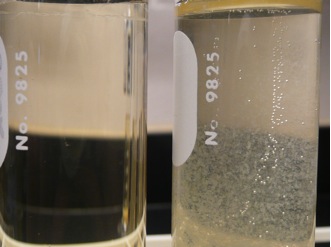
Close up of bentonite in action. The sample on the left is untreated and the sample on the right is the same wine with bentonite added. After only a few minutes the interaction of the bentonite and proteins is apparent.
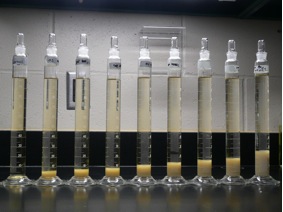
A bench trial with a wide range of bentonite additions. These samples have been allowed to settle overnight. Notice the large amount of lees bentonite creates. Bentonite slurry is made with water. It is extremely important that the water used to hydrate the benotonite be of the highest quality. Chlorine or minerals can cause problems later.

Different levels of haze induced by an 80C treatment for 6 hours. A piece of tape is placed in the background to help see the hazing. The treatment range for this wine is too limited. The wine will need to be re-analyzed using a larger treatment range. The reduction in haze is apparent over increases in bentonite.
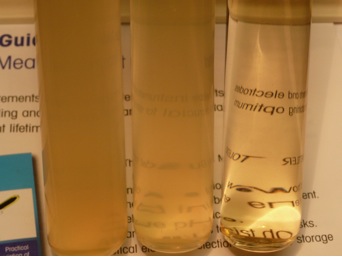
Several methods can be used to check for clarity. One of those is to hold the samples over a sample of print and observe how much the text is obscured.
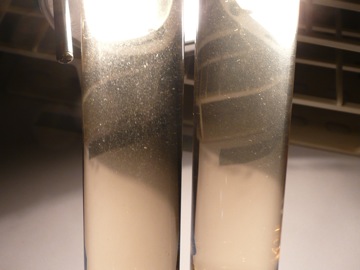
Another method to analyze clarity levels of the trials is to shine a light through the back of the sample in a dark room as demonstrated here.
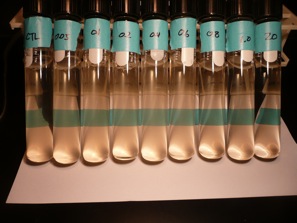
A wine treated with a fine range of additions. The reduction in haze is hard to see between treatments. Comparing the control with the 1.0 g/L treatment reveals a reduction in hazing.

This wine was treated with 0.1 g/L, 0.2 g/L and 0.4 g/L bentonite. The amount of haze produced is greatly minimized by the 0.2 g/L bentonite addition. An addition of between 0.1 g/L and 0.2 g/L might be ideal for this wine.
[wp_geo_map]

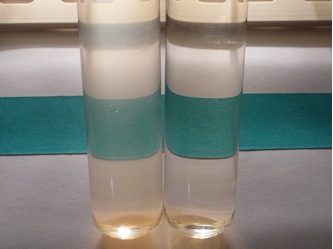



1 Response
nitric oxide supplement negative side effects
Wine Heat Stability Testing Methods